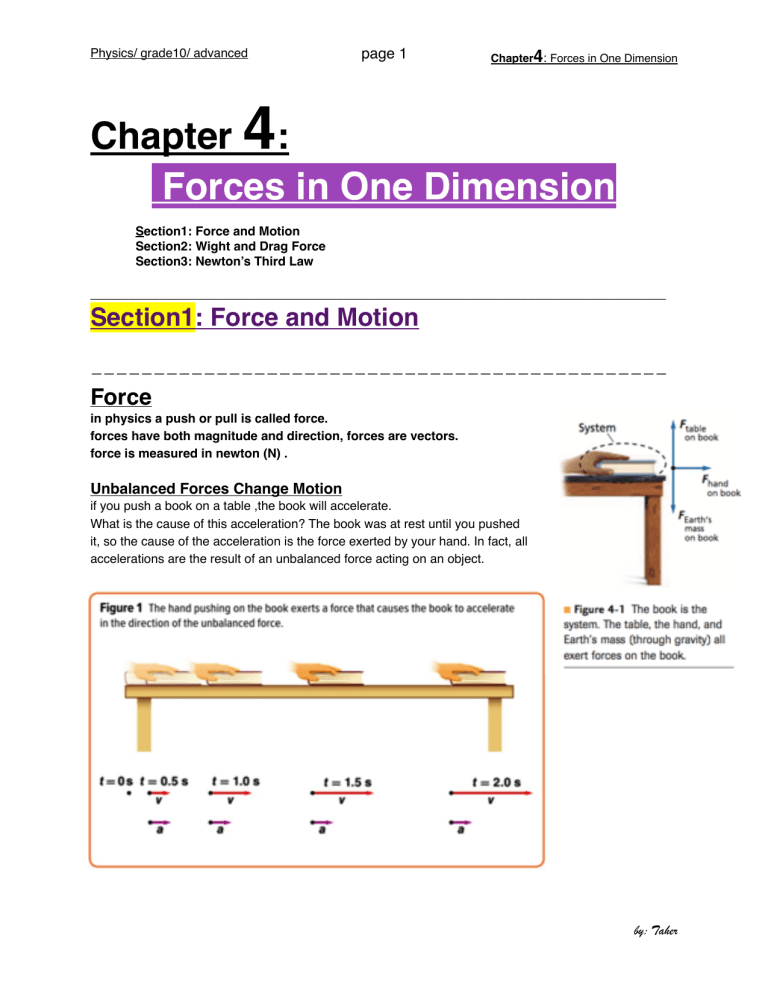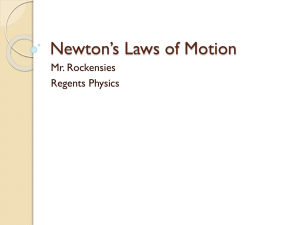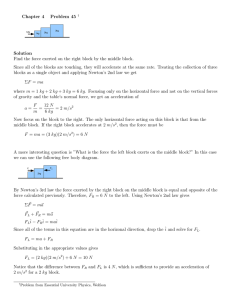
Physics/ grade10/ advanced page 1 Chapter4: Forces in One Dimension 4 Chapter : Forces in One Dimension Section1: Force and Motion Section2: Wight and Drag Force Section3: Newton’s Third Law ___________________________________________________________________________ Section1: Force and Motion —————————————————————————————————————————————— Force in physics a push or pull is called force. forces have both magnitude and direction, forces are vectors. force is measured in newton (N) . Unbalanced Forces Change Motion if you push a book on a table ,the book will accelerate. What is the cause of this acceleration? The book was at rest until you pushed it, so the cause of the acceleration is the force exerted by your hand. In fact, all accelerations are the result of an unbalanced force acting on an object. by: Taher Physics/ grade10/ advanced page 2 Chapter4: Forces in One Dimension Systems And External World The object or objects of interest, called the system. Every thing around the system with which the system can interact is called the external world see figure FORCES ARE TWO KINDS 1- Contact Force: A contact force exists when external world touches a system, exerting a force on it. Example: pushing a ball , holding bag, wind pushes a boat,…. 2- Field Force: A field force exists when external world exerting a force on an object or system without touching it. Example: gravitational force on a ball , magnetic force on iron,.. Forces result from interactions; thus, each force has a specific cause called the agent. For example, when you push your textbook, your hand (the agent) exerts a force on the textbook (the system). If there are not both an agent and a system, a force does not exist. What about the gravitational force? If you allow your text- book to fall, the agent is the mass of Earth exerting a field force on the book. Free-Body Diagram (FBD) is a physical representation that shows the forces acting on a system. Application FBD Drew free-body diagram for each - Car exerted to gravity of Earth, engine force forward, wind resistance backward, normal force from earth upwards. - Ball hanged to a string exerted to force of gravity downward, and force of string tension upward. by: Taher Physics/ grade10/ advanced page 3 Chapter4: Forces in One Dimension - Boat in water exerted to force from water upwards, engine force forward, water resistance backward, force of gravity . Combining Forces and Net Force When many unbalanced forces exert on one object ,this object will move with an acceleration in the direction of one force equals all forces ,we call this one force the net force.the net force can replace all combing forces. if the forces were balanced the object will not move, that mean the net force is zero. representing forces by vectors is helpful to understand net force net force is the sum of all forces using vector roles . by: Taher Physics/ grade10/ advanced page 4 Chapter4: Forces in One Dimension 6-Two horizontal forces, 225 N and 165 N, are exerted on a canoe. If these forces are applied in the same direction, find the net horizontal force on the canoe. 7-If the same two forces as in the previous problem are exerted on the canoe in opposite directions, what is the net horizontal force on the canoe? Be sure to indicate the direction of the net force. 8-Three confused sled dogs are trying to pull a sled across the Alaskan snow. The first pulls east with a force of 35 N, the second also pulls east but with a force of 42N, and the third pulls west with a force of 53 N. What is the net force on the sled? Acceleration and Force if you investigate by exerting a unbalanced force to an object and calculated each of force ,distance, time, velocity, and acceleration for a few forces , you will find a liner relationship between accelerations and forces exerted. If you repeated the investigation by applying the same force to objects with different masses(m, 2m,3m), the one with the most mass will have the smallest acceleration and the one with the least mass will have the greatest acceleration. all of that could be represented by this equation a= Fnet /m. by: Taher Physics/ grade10/ advanced page 5 Chapter4: Forces in One Dimension Newton’s Second Law Newton’s Second Law states that” the acceleration of an object is proportional to the net force and inversely proportional to the mass of the object being accelerated”. This law is based on observations of how forces affect masses and is represented by the following equation or The acceleration of an object is equal to the sum of the forces acting on the object divided by the mass of the object Fnet a= m Fnet = ma 9- A spring scale is used to exert a net force of 2.7 N on a cart. If the cart’s mass is 0.64 kg, what is the cart’s acceleration? 10- Kamaria is learning how to ice skate. She wants her mother to pull her along so that she has an acceleration of 0.80 m/ s . If Kamaria’s mass is 27.2 kg, with what force does her mother need to pull her? (Neglect any resistance between the ice and Kamaria’s skates) FIGHTING OVER A PILLOW Aya is holding a pillow with a mass of0.30 kg when Sarah decides that she wants it and tries to pull it away from Aya. If Sarah pulls horizontally on the pillow with a force of 10.0 N and Aya pulls with a horizontal force of 11.0 N, what is the horizontal acceleration of the pillow? m=0.30kg Fsarah= 11.0N Faya= 10.0N a=? by: Taher page 6 Physics/ grade10/ advanced Chapter4: Forces in One Dimension Newton’s First Law What is the movement of an object when the net force acting on it is zero?………… if Fnet=0 what is acceleration ? a= …………… dose its velocity change? ……………….. Newton first law: “an object that is at rest will remain at rest, and an object that is moving will continue to move in a straight line with constant speed, if and only if the net force acting on that object is zero” Fnet =0 → a=0 → v= constant Inertia Newton’s first law is sometimes called the law of inertia because inertia is the tendency of an object to resist changes in velocity. is inertia a force? …No objects with more mass have more inertia. Equilibrium : According to Newton’s first law, a net force causes the velocity of an object to change. If the net force on an object is zero, then the object is in equilibrium. An object is in equilibrium if it is moving at a constant velocity. (( Equilibrium ←→ a=0 ,(v=constant or v=0)) Section1 summary A force is a push or a pull. Forces have both direction and magnitude. A force might be either a contact force or a field force. Newton’s second law states that the acceleration of a system equals the net force acting on it divided by its mass. a= Fnet /m Newton’s first law moving will continue to move in a straight line with constant speed, if and only if the net force acting on that object is zero. An object with zero net force acting on it is in equilibrium. by: Taher Physics/ grade10/ advanced page 7 Chapter4: Forces in One Dimension Section 2 : Weight and Drag Force Main Idea :Newton’s second law can be used to explain the motion of falling objects. An object’s weight is the gravitational force experienced by that object. This gravitational force is a field force whose magnitude is directly proportional to the mass of the object experiencing the force. Fnet = m a so Fg = m g Fg= weight (N) m= mass (kg) g= gravitational field (m/s2) ,it is vector quantity g=9.8 m/s2 near earth surface. Fg force direction is always to the Earth center. g differ from place to place ,and from Earth to another planet. so the weight will differ (while mass is not changes). Scales When you stand on a scale ,the scale exerts an upward force on you. Because you are not accelerating, the net force acting on you must be zero. Therefore the magnitude of the force exerted by the scale ( F scale on you ) pushing up must equal the magnitude of (Fg) pulling down on you.Inside the scale, springs provide the upward force necessary to make the net force equals zero. a=0 Fnet =0 Fscale = Fg _ What is you weight? (g=9.8m/s2 ………………………………………………………………………. by: Taher page 8 Physics/ grade10/ advanced Chapter4: Forces in One Dimension Apparent Weight What happens if you stand on a scale in an elevator? As long as you are not accelerating, the scale will read your weight. What would the scale read if the elevator accelerated upward? Figure shows the pictorial and physical representations for this situation.You are the system, and upward is the positive direction. Because the acceleration of the system is upward, the net force must be upward. The upward force of the scale must be greater than the downward force of your weight. Therefore, the scale reading is greater than your weight. If you ride in an elevator accelerating upward, you feel as if you are heavier because the floor presses harder on your feet. On the other hand, if the acceleration is downward, then you feel lighter, and the scale reads less than your weight. The force exerted by the scale is an example of apparent weight, which is the support force exerted on an object. Fnet= Fscale +(-Fg) a ↑ is upward Fscale > Fg a ↓ is downward Fscale < Fg Weightlessness : object’s apparent weight =0 that happens when you are moving downward ( elevator cable broke ) with an acceleration a=g and no contact force acting to support you. that mean you are falling . by: Taher page 9 Physics/ grade10/ advanced Chapter4: Forces in One Dimension Example 3 real and apparent weight Your mass is 75.0 kg, and you are standing on a bathroom scale in an elevator. Starting from rest, the elevator accelerates upward at 2.00 m/s2 for 2.00 s and then continues at a constant speed. Is the scale reading during acceleration greater than, equal to, or less than the scale reading when the elevator is at rest? m=75.0kg Fscale =? a= 2.00 m/s2 t=2.00s g=9.8 m/s2 solving: Newton 2nd law: Fnet = m a Fnet = F scale + ( -Fg) Fscale = Fnet + Fg Elevator at rest Elevator accelerates upward a=0 a=+2m/s2 Fnet = ma = 75.0 X0 =0 Fnet = ma = 75.0 X2 =150 N Fscale = Fnet + Fg Fscale = Fnet + Fg Fscale= 0 + Fg Fscale= (150) + mg Fscale = mg Fscale= 150 + (75.0) X (9.8) Fscale= (75.0) X (9.8) = 735 N Fscale= 885 N The scale reading when elevator is accelerating (885N) is lager than the scale reading when the elevator is at rest (735N). 20- On Earth a scale shows that you weigh 585N , (g=9.8 m/s2) a- What is your mass? b- What would the scale read on the Moon (g=1.60 m/s2) by: Taher Physics/ grade10/ advanced page 10 Chapter4: Forces in One Dimension Drag Force A drag force is the force exerted by a fluid (air or water) on an object opposing motion through the fluid. This force is dependent on the motion of the object, the properties of the object, and the properties of the fluid that the object is moving through. For example, as the speed of the object increases, so does the magnitude of the drag force.The size and shape of the object also affect the drag force. The fluid’s properties, such as its density and viscosity, also affect the drag force. Terminal Velocity The constant velocity that is reached when the drag force equals the force of gravity is called the terminal velocity. Falling objects exert for two forces ,force of gravity , and drag force by air. The drag force on an object increases as its velocity increases.When the drag force equals the gravitational force, the object is in equilibrium so it no longer accelerate ,it will move at constant velocity called terminal velocity. Fd = Fg velocity) → (a=0 ) → v= constant ( terminal Skydivers can reach terminal velocity of about 60m/s. parachute man reaches terminal velocity of about 5m/s. Section2 summary - The object’s weight (Fg ) depends on the object’s mass and the gravitational field at the object’s location. Fg =mg - An object’s apparent weight is the magnitude of the support force exerted on it. An object with no apparent weight experiences weightlessness. - A falling object reaches a constant velocity when the drag force is equal to the object’s weight. The constant velocity is called the terminal velocity. The drag force on an object is determined by the object’s weight, size, and shape as well as the fluid through which it moves. by: Taher Physics/ grade10/ advanced page 11 Chapter4: Forces in One Dimension Section 3 : Newton’s Third Law Main Idea: All forces occur in interaction pairs. interaction pairs You can see that each system exerts a force on the other. The two forces, F A on B and F B on A , are the forces of interaction between the two. The forces F A on B and F B on A are an interaction pair, which is a set of two forces that are in opposite directions, have equal magnitudes, and act on different objects. Sometimes, an interaction pair is called an action and reaction pair. the two forces either exist together or not at all. examples the force exerted by the boy on the rope is equal in magnitude and opposite in direction to the force exerted by the rope on the boy. book on a table , planet and Sun, You and Earth walking , swimming , flying ,.. Newton’s Third Law The force of A on B is equal in magnitude and opposite in direction of the force of B on A F A on B = - F B on A by: Taher Physics/ grade10/ advanced page 12 Chapter4: Forces in One Dimension Using Newton’s Third Law A ball resting on a table is part of two interaction pairs The two forces acting on the ball are F table on ball and F Earth’s mass on ball . These forces are not an interaction pair. see Example 4 (physics book, page 108) Tension Tension is simply a specific name for the force that a string or rope exerts. (ropes are massless). In figure ( bucket hanged to a top ). According to Newton’s 3rd law FT (Bottom on top) = FT (Top on bottom) and FT (Top on bottom = Fg The Normal Force FN The normal force is the perpendicular contact force that a surface exerts on another surface. The normal force always is perpendicular to the plane of contact between two objects, The normal force is not always equal to the object’s weight. FN = Fg by: Taher page 13 Physics/ grade10/ advanced Chapter4: Forces in One Dimension Example : Lifting a Bucket. A 50.0 kg bucket is being lifted by a rope. The rope will not break if the tension is 525 N or less. The bucket started at rest, and after being lifted 3.0 m, it moves at 3.0 m/s. If the acceleration is constant, is the rope in danger of breaking? analyzing : m=50.0 kg FT=? , vi=0 , △x =3.0m vf= 3.0m/s , Fnet = FT +(- Fg) FT = Fnet + Fg Find Fnet : Newton’s 2nd Law : Fnet= ma Find a : movement equation: v2f = v2i +2 a △x (3.0)2 = (0)2 + 2XaX(3.0) a = 9 / 6 = 1.5 m/s2 return to find Fnet Fnet= ma = 50.0 X 1,5 = 75 N return to find FT FT = Fnet + Fg = Fnet + mg FT = 75 + (50.0)X (9.8) =565N FT> 525 N the rope will break. Section3 summary -All forces occur in interaction pairs -Newton’s third law states that the two forces that make up an interaction pair of forces are equal in magnitude, but opposite indirection and act on different objects. In an interaction pair,F does not causeF . The two forces either exist together or not at all. F A onB =-F B on A -The normal force is a support force resulting from the contact between two objects. It is always perpendicular to the plane of contact between the two objects by: Taher




